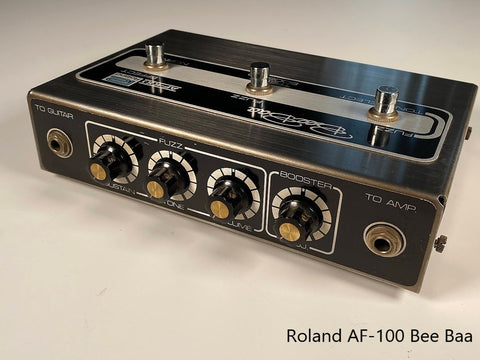It must be hard to find the guitarist who never used or owned BOSS compact effector series. It has helped many legendary professional guitarists for decades, and its tone and play have been fascinating amateur guitarists as well not only in its hometown Japan but also around the world. Even in current digital music era, this tiny analog type solution is still loved and will be in future too, I believe.
BOSS is the brand that belongs to Roland group, of which origin of effect pedals is “Ace tone” that was born in 1960 in Japan. Ace tone is known as unique pedals such as FM-2/3 Fuzz Master, LH-100 Stereo Phaser, QH-100 Graphic Equalizer and so on, but it was not welcomed so much at that time when market was not familiar with such devices.

In 1972, Roland was born as the manufacturer of rhythm machine and synthesizers. RE-201 Echo Chamber called “Space Echo” is also released in these days. They also release guitar effect pedals such as AS-1 Sustainer, AF-100 Bee Baa Fuzz, AF-50 Bee Gee Fuzz etc., which became the basis for BOSS compact pedals.


The brand name “BOSS” had started in ’76 on “CE-1 Chorus Ensemble” (actually the very fast BOSS is “B-100 Pre-Amplifier” in ’74 for US market with very small volume) followed by “GE-10 Graphic Equalizer” that is known as the gear for Eddie Van Halen.

Then, in 1977 the first BOSS compact effector series was released with “OD-1 Over Drive”, “PH-1 Phaser” and “SP-1 Spectrum” (a sort of parametric EQ). From this first model, BOSS have not been changed the basic features such as same body housing with different colors in accordance with effect types and noise less FET foot switch solution. Even this compact pedal started to apply digital control circuit, these basic features remained same that must be not easy though, this Japanese style design commitment philosophy must be one of the major reasons that BOSS compact effector series have been loved and got to be de-facto standard pedal.
Now, many enthusiast around the world love the old “MIJ” Made in Japan BOSS pedals, that have different tone to current ones. For your choice of vintage BOSS pedals, I would here introduce some features of old MIJ BOSS as below.
- Black label: MIJ (and some old Taiwan made) has black label on the panel
- Silver screw: From 1st model to around ’81, Silver screw was applied for battery cavity.
- Transparent switch: It can be seen on very early model like ’77 to ’78.
- Stamp serial: In ‘70s it is stamped nearby switch in battery cavity and after that it is stamped on paper label in battery cavity.
- Back panel screw with washers: Only seen on early generation ‘70s models.



Let’s get it to enjoy heritage.

